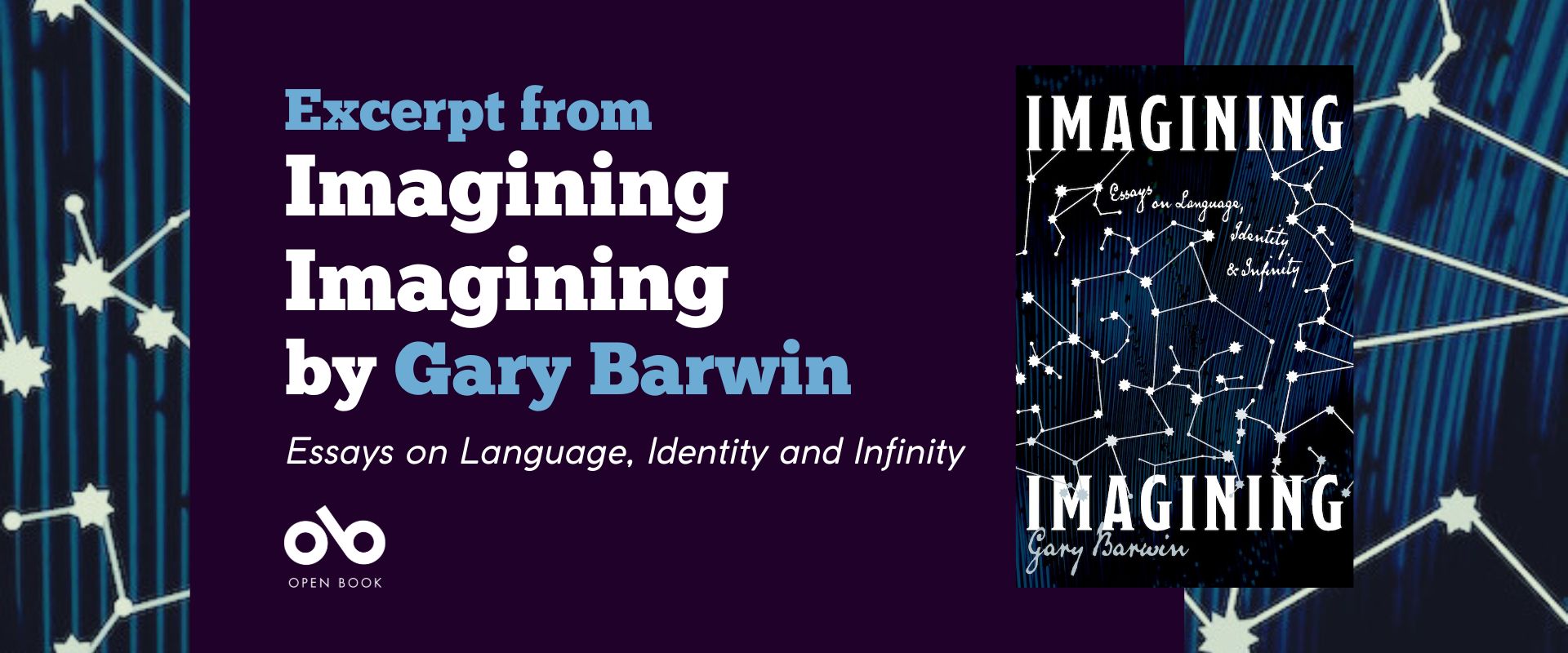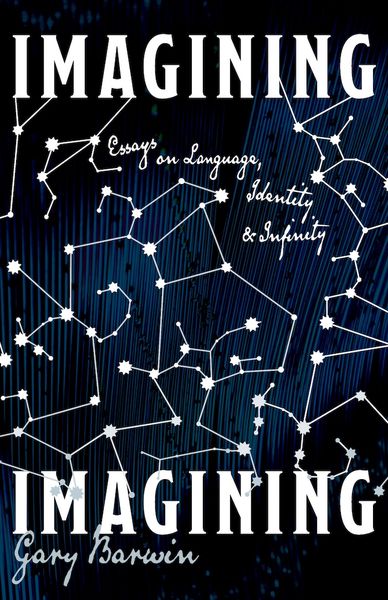"A Paradigm Shift That Has Become Entirely Normalized" Read an Excerpt from Gary Barwin's Essay Collection, Imagining Imagining
Renaissance man Gary Barwin has exhibited art, written music, and published in virtually every literary genre, to acclaim that has included nominations for the Scotiabank Giller Prize and Governor General's Award as well as numerous other honours, both internationally and at home. A beloved writing teacher and mentor, he is a fixture of the Hamilton literary scene.
We're excited to be kicking off the New Year with an excerpt from his anticipated book of essays, Imagining Imagining: Essays on Language, Identity and Infinity (Wolsak & Wynn).
In Imagining Imagining, Barwin doesn't shy away from the very big ideas his subtitle brings up, thinking deeply but with his trademark wit and winsome quality about no less than art, story, death, dreams, and more.
Moving from his childhood home of Ireland to his adopted hometown of Hamilton, Imagining Imagining is funny and life-affirming, woven together with a belief in the power of stories and creating. The essays are smart, absorbing, and full of heart – a perfect read for a new start.
Here we're sharing a section from "The Selected Walks", in which Barwin ruminates on his experiences with music and walking, and how the historically-unprecedented ability to carry our own soundtrack has changed our experiences of both.
Excerpt from Imagining Imagining: Essays on Language, Identity and Infinity by Gary Barwin:
It's December and I’m in grade seven playing second alto saxophone in the Intermediate School Band. We’re playing “Silver Bells.” I can’t recall ever having heard the song, but I found the second alto part very moving. We had the harmony to the “Children laughing, people passing” lyric, and I remember a feeling of exquisite tenderness in the downward leap on “laughing,” which then repeated on “passing.” We humans, how vulnerable we are, but how infinitely touching. I also realized that my part gave me instructions on what to feel, what state to inhabit emotionally. Mezzo forte with a delicate little decrescendo to mezzo piano. My middle school heart was called to experience this intimate human moment as if I were a method actor playing a role. I could merge with all those who felt these big feelings, could be free of my own early teenage tube man of emotions, all that absurd gravitas-less twisting and perennial near deflation. From my second alto chair, I could experience the wide range of what it means to be human, even experience emotions that I understood little about or that were outside the experience of a suburban Ottawa teen. Melancholy, joy, nobility, grief, compassion, insouciance, heroism, happiness, resilience, sexiness, courage. All in simplified band arrangements ranging from the theme to Hogan’s Heroes to Dvořák’s Slavonic Dances. And these feelings seemed embodied in the material of the music, the relationship between notes, timbre, dynamics and tempo. By paying attention to what seemed inherent, to the semantic inner life of the music – by listening to what was there in the world, by inhabiting it fully, the walls of the middle school band room fell away and I was in a larger life.
*
I love the syncretic web of experience. Me, in 2023, a Jewish man, born in Northern Ireland and now listening on an iPhone in a conservation area outside Hamilton, Ontario, to a Catholic mass with music composed by a Lutheran in Leipzig in the mid-eighteenth century and presented to the King of Poland and Holy Roman Empire Elector of Saxony. I imagine trying to explain this to one of my medieval ancestors. It reminds me of a poem that I once read where Fred and Wilma Flintstone go to the Grand Canyon and send Barney and Betty a postcard. Fred and Wilma don’t think the canyon is a big deal but are mightily impressed by the concept of a postcard.
*
Nineteen seventy-eight. On a tour through Michigan with my high school jazz band, the second trumpeter showed us all this cool new thing he’d bought from a recent trip to New York City: A Sony Walkman. It was a portable audio cassette player with small headphones. I tried it. It astounded me. The sound was entirely inside your head – wherever you walked, you had a soundtrack. This was a revolutionary thing. I’d seen old men – my grandfather included – listen to the news or a ballgame while in the park on a portable radio, sometimes using the single earbud provided. You could hear the broadcast, but it wasn’t inside your head. Inside and out were one. With the Walkman, your brain had music right inside it. It was a concert hall. It was a paradigm shift that has become entirely normalized. Everyone has a phone now and most people have earbuds. Audio is portable. We routinely carry around our own soundtrack wherever we go. We don’t need to whistle or sing, which is something external (though some still do, often humorously oblivious). The sound is inside us and at the same time surrounds us like the dark.
Your CanLit News
Subscribe to Open Book’s newsletter to get local book events, literary content, writing tips, and more in your inbox
I went walking with my dog Happy last night. As it was dark and we were in a park, I thought of Charles Ives’ Central Park in the Dark, a companion piece to his more famous The Unanswered Question. Ives’ orchestration captures the sound of darkness, the thickness of it, the sense that one is walking through not an absence but a tactile presence. And above the creeping dark of the strings, a mysterious contemplative clarinet and other solo instruments ruminate. (At least until the moment where the unhinged jollity of Hello My Baby intrudes, a moment of monkey mind amid introspection.)
My park is Churchill Park, a block away from my home. Because of its proximity to Cootes Paradise and Lake Ontario, the temperature is distinctly colder than the surrounding neighbourhood. The grass is often damp, and deer, having emerged from the adjoining forest, constellate silently in the soccer fields. My last dog, Dude, would sometimes accidently find himself only a metre or so away from a deer and then start in surprise. Happy, on the other hand, spies them from far away and bolts, chasing them as they spring up and dart back into the woods. I’ve been walking in this park for over thirty years and circling around it, I recall Charles Darwin’s path at the back of his property where he would walk round and round while thinking. The routine of the route apparently helped with his thinking. It was something of a ritual, the expectedness and lack of surprise combined with the steady rhythm of walking freed his mind to wander down other paths, to venture down new neural pathways and follow thoughts wherever they might go. I aspire to such satisfying reverie. Sometimes it happens despite the Hello My Baby intrusions.
Last night, I considered how solo walking, especially at night, is not like being in a bell jar but like a diving bell. You’re carrying your own environment with you yet have a connection to the outside – the air tube. It’s ultimately about the self and our connection and individuation from the world. Is it “I am because my little world knows me?” or “I know the world and so I know myself?” Mark Strand:
In a field
I am the absence
of field.
. . . . . . .
We all have reasons
for moving.
I move
to keep things whole.
We send out feelers, signals. We echolocate. It’s psy(e)chogeography. We sense the shape of our inner landscape by travelling through the one that surrounds us.
Walking with my dog expands this landscape. I think about how he echolocates, what sense of the world and himself he might experience, how we experience each other – a kind of conceptual leash between us, a dog-human umbilical cord. At night, I walk Happy without a leash, so our connection, like Philip Pullman’s daemons in The Golden Compass, is entirely relational, an invisible attractive force between us. We walk in parallel yet always with one eye on the other.
Earlier I quoted Mary Ruefle’s line about the creation of the lyric poem, “the moon was witness to the event and... the event was witness to the moon.” That’s like my dog and me. The world and me. And walking while wearing headphones, the beginning and end of a Möbius strip made of music, story and imagination. A strange loupe.
_____________________________________________________
Excerpt taken from “The Selected Walks”, in Imagining Imagining: Essays on Language, Identity and Infinity by Gary Barwin. Published by Wolsak & Wynn Ltd. Copyright Gary Barwin, 2023. Reprinted with permission.
Gary Barwin is a writer, composer, and multidisciplinary artist and the author of twenty-six books including Nothing the Same, Everything Haunted: The Ballad of Motl the Cowboy, which won the Canadian Jewish Literary Award. His national bestselling novel Yiddish for Pirates won the Leacock Medal for Humour and the Canadian Jewish Literary Award, was a finalist for the Governor General’s Award for Fiction and the Scotiabank Giller Prize, and was long-listed for Canada Reads.
Barwin has been writer-in-residence at University of Toronto (Scarborough), Laurier, Western University, McMaster University, and the Hamilton Public Library, Hillfield Strathallan College, Sheridan College, and Young Voices E-Writer-in-Residence at the Toronto Public Library. He has taught creative writing at a number of colleges and universities, to at-risk youth in Hamilton through the ArtForms program and currently mentors through the Vancouver Manuscript Intensive. His writing has been published in hundreds of magazines and journals internationally and his writing, music, media works, and visuals have been presented and broadcast internationally. Though born in Northern Ireland to South African parents of Ashkenazi descent, Barwin lives in Hamilton, Ontario, and at garybarwin.com.






